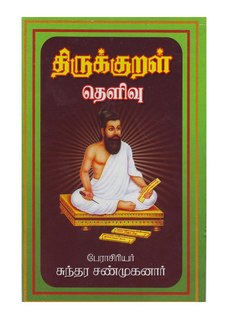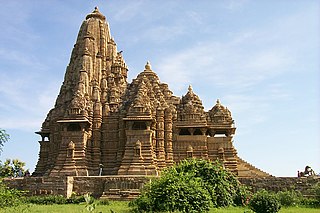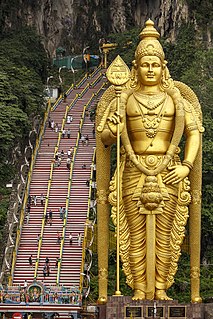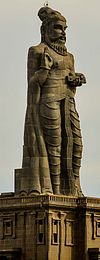
Thiruvalluvar, commonly known as Valluvar, was a celebrated Tamil poet and philosopher. He is best known for authoring the Thirukkuṛaḷ, a collection of couplets on ethics, political and economical matters, and love. The text is considered the greatest work of the Tamil literature and one of the finest works on ethics and morality.

The Ashtalakshmi Kovil is a Hindu temple, which lies on the shorelines near the Elliot's beach, in Chennai, India. The temple is dedicated to the goddess Lakshmi, and her eight primary forms – the Ashtalakshmi – the giver of all eight forms of wealth, namely, offspring, success, prosperity, wealth, courage, bravery, food, and knowledge. The sanctorums are depicted on a multi-tier complex in such a way that visitors could visit all the shrines without stepping over any of the sanctorums.

Valluvar Kottam is a monument in Chennai, dedicated to the classical Tamil poet philosopher Valluvar.

The Thiruvalluvar Statue, or the Valluvar Statue, is a 133-feet tall stone sculpture of the Tamil poet and philosopher Valluvar, author of the Tirukkural, an ancient Tamil work on secular ethics and morality. It is located atop a small island near the town of Kanyakumari on the southernmost point of the Indian peninsula on the Coromandel Coast, where two seas and an ocean meet. The statue was sculpted by the Indian sculptor V. Ganapati Sthapati, who also created the Iraivan Temple, and was unveiled on the millennium day of 1 January 2000 by the then Chief Minister M. Karunanidhi. It is currently the 25th tallest statue in India.

The Tirukkural, or shortly the Kural, is a classic Tamil text consisting of 1,330 couplets or Kurals, dealing with the everyday virtues of an individual. It is one of the two oldest works now extant in Tamil literature in their entirety, the other being the Tolkappiyam. Considered one of the greatest works ever written on ethics and morality, chiefly secular ethics, it is known for its universality and non-denominational nature. It was authored by Valluvar, also known in full as Thiruvalluvar. The text has been dated variously from 300 BCE to 5th century CE. The traditional accounts describe it as the last work of the third Sangam, but linguistic analysis suggests a later date of 450 to 500 CE.

Jagannath Puri Temple Chennai is a Hindu temple dedicated to the divine trinity Jagannath, Baladeva and Subhadra in Chennai, India. The temple located in Kannathur off the East Coast Road by the seaside is built in Kalinga architecture reminiscent of the Jagannath Temple, Puri. The temple has shrines dedicated to Shiva, Ganesh, Bimala. The annual Rathyatra is the main festival celebrated.
The Tirukkural, shortly known as the Kural, is a classic Tamil sangam treatise on the art of living. Consisting of 133 chapters with 1330 couplets or kurals, it deals with the everyday virtues of an individual. Authored by Valluvar between the third and first centuries BCE, it is considered one of the greatest works ever written on ethics and morality and is praised for its universality and non-denominational nature.
Yu Hsi is a Taiwanese Tamil poet and scholar, who has translated the Tirukkural and the poems of Subramaniya Bharathi and poet Bharathidasan in Mandarin. He is the founder president of the Tamil Sangam in Taiwan. He has received various awards, including awards from Seoul World Academy of Arts and Culture (2004), Thiruvalluvar award (2014), and a felicitation from former President of India A. P. J. Abdul Kalam.
William Henry Drew was a Christian missionary to India who rendered the Tirukkural into English. However, he translated only the first 630 couplets (kurals).
John Lazarus (1845–1925) was a Christian missionary to India who rendered the Tirukkural into English. He revised the work of his predecessor William Henry Drew, who had already translated the first 63 chapters of the Tirukkural, and translated the remaining portion of the Kural text.
Tirukkural remains one of the most widely translated non-religious works in the world. As of 2014, there were at least 57 versions available in the English language alone. English, thus, continues to remain the language with most number of translations available of the Kural text.
As of 2015, there are at least three Gujarati translations of the Tirukkural.
Manakkudavar was a Tamil poet and commentator known for his commentary on the Thirukkural. His is the earliest of the available commentaries on the ancient work, and hence considered to bear closest semblance with the original work by Valluvar. He was among the canon of ten medieval commentators of the Kural text most highly esteemed by scholars. He was also among the five ancient commentators whose works had been preserved and made available to the Modern era, the others being Pari Perumal, Kaalingar, Paridhi, and Parimelalhagar.
S. M. Michael was one of the early 20th-century translators of the Tirukkural into English.
The Book of Aṟam, in full Aṟattuppāl, also known as the Book of Virtue, the First Book or Book One in translated versions, is the first of the three books or parts of the Kural literature, a didactic work authored by the ancient Indian philosopher Valluvar. Written in High Tamil distich form, it has 38 chapters each containing 10 kurals or couplets, making a total of 380 couplets, all dealing with the fundamental virtues of an individual. Aṟam, the Tamil term that loosely corresponds to the English term 'virtue', correlates with the first of the four ancient Indian values of dharma, artha, kama and moksha. The Book of Aṟam exclusively deals with virtues independent of the surroundings, including the vital principles of non-violence, moral vegetarianism or veganism, veracity, and righteousness.
Tiruvalluva Maalai, literally 'Garland of Valluvar', is an anthology of ancient Tamil paeans containing fifty-five verses each written by different poets praising the ancient work of the Kural and its author Valluvar. With the poets' time spanning across centuries starting from around 1st century CE, the collection is believed to have reached its present form by 11th century CE. With the historical details of the ancient philosopher and his work remaining obscure, much of the legend on the Kural and Valluvar as they are known today are chiefly from this work. The collection also reveals the name of the author of the Kural text as 'Valluvar' for the first time, as Valluvar himself composed the Kural text centuries earlier without indicating his name anywhere in his work. Reminiscing this, Monsieur Ariel, a French scholar of the 19th century, famously said of the Tirukkural thus: Ce livre sans nom, par un autre sans nom.
Mamulanar was a poet of the Sangam period, to whom 31 verses of the Sangam literature have been attributed, including verse 8 of the Tiruvalluva Maalai.
The dating of the Tirukkural, and by extension the period of its author Valluvar, has been a subject of intense debate among scholars for centuries, and it continues to remain so. The Tamil Nadu government has ratified 31 BCE as the year of birth of Valluvar. Still the precise date as to when Valluvar completed writing the Kural text remains murky. This article speaks about various dates arrived at by various scholars over time.

Thiruvalluvar year, also known as the Valluvar year, is an officially recognized Tamil calendar system for use in Tamil Nadu. When comparing it with the widely used Gregorian calendar, Thiruvalluvar year will have an additional 31 years. For instance, the year 2018 in Gregorian calendar way is 2049 in the Thiruvalluvar year.













